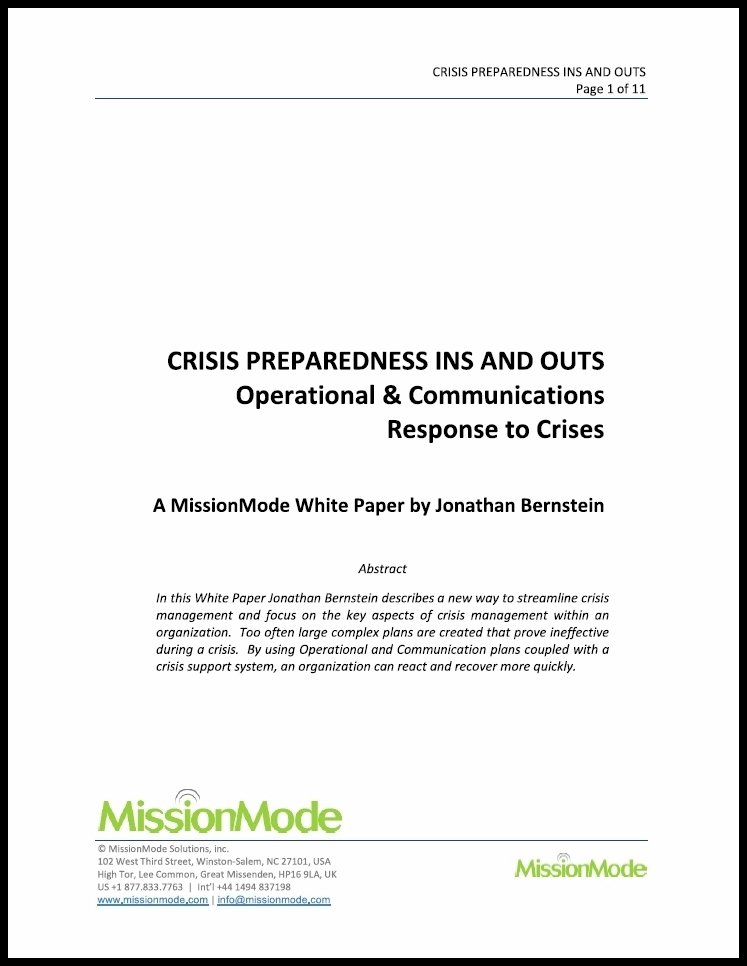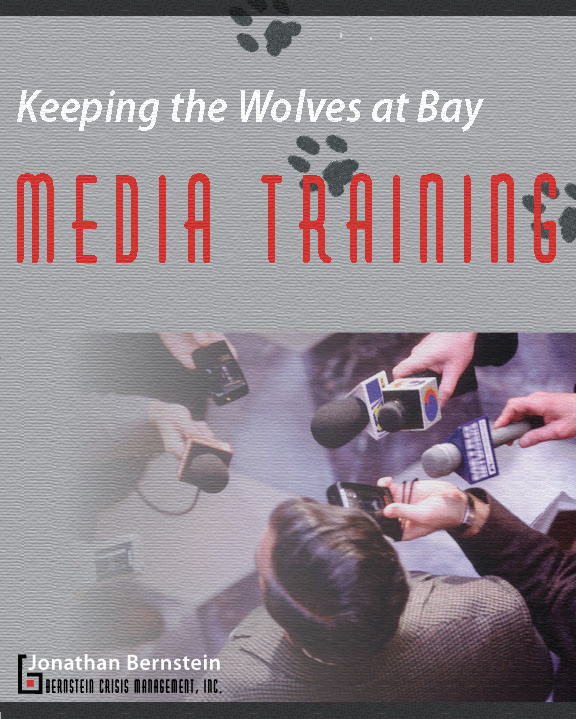|
|

|
CRISIS MANAGER
The Internet Newsletter about Crisis Management
Editor: Jonathan Bernstein
"For Those Who Are Crisis Managers,
Whether They Want to be or Not"
ISSN:1528-3836
© 2010 Jonathan Bernstein
|
Volume XI, Number 10
| June 3, 2010
|
|
|
FROM THE EDITOR
I was recently commissioned to write a white paper for MissionMode Solutions, a company offering a virtual command center, entitled Crisis Preparedness Ins and Outs -- Operational and Communications Response in Crises. With their permission, I'm pleased to bring you an excerpt from that paper, How to Prepare for Crises - An Inside Job, and also provide Crisis Manager readers with a link via which you can get a copy of the full publication. It has some of my best thinking on this subject, so I hope you find it valuable.
Then, I'm very pleased to feature another piece by one of the grandmasters of our industry, Jim Lukaszewski, as originally published at his blog. He addresses an always challenging situation, When Death is the Crisis.
Want to learn more about crisis management? Please check out the Bernstein Crisis Management blog I manage with my son Erik, as well as the Crisis Management blog I host over at Carter McNamara's Free Management Library, where you'll also find a dozen or more other excellent blogs.
As always, if you like what you see, please share it with others by using the "Forward Email" link at the bottom of the ezine and tell them to subscribe! IMPORTANT NOTE: If you just "Forward" using your own email program's "Forward" function and your recipient thinks they're being spammed, they can click on the Opt Out link and opt YOU off the list. So use the "Forward Email" link, please.

My best to all, Jonathan
|
HOW TO PREPARE FOR CRISES
- AN INSIDE JOB
By Jonathan Bernstein
|
There are five steps to effective crisis preparation:
1. Vulnerability Assessment
A Vulnerability Audit is a multi-disciplinary risk assessment to determine current and potential areas of operational and communications weakness and strength, and to identify potential solutions, because weaknesses may result in emergencies or crises of varying magnitudes if not corrected. Ideally, every functional area of an organization is examined to identify anything that could lead to or exacerbate a crisis. may result in emergencies or crises of varying magnitudes if not corrected. Ideally, every functional area of an organization is examined to identify anything that could lead to or exacerbate a crisis. There are professional iterations of this process offered by crisis management professionals, but the simplest starting point can be as easy as holding regular "what if" brainstorming sessions at which managers are invited to suggest worst-case scenarios that could threaten the organization. Then the management team examines, as thoroughly as possible, how prepared the organization is, now, to respond to such a situation and, if under-prepared, what it has to do to get up to speed.
2. Crisis Planning - Operational and Communications
When assessed during the vulnerability process, one prominent West Coast university was found to have no less than six different crisis-related plans, each of them created by different employees without any coordination between the originating departments. The documents included:
- Natural disaster response plan
- Facilities emergency plan
- Fire response plan
- Crisis communications plan
- Emergency operations plan
- Web emergency plan
As a result of this haphazard approach to planning, there were gaping holes in crisis preparedness as well as some significant self-inflicted wounds. For example, during a natural disaster such as an earthquake, different plans would have had the same senior-level staff member in two different parts of the campus at the same time.
In fact, only two types of planning needs to be done:
- Operational - what do we do, who does it, when is it done, etc.
- Communications - what do we say, who says it, how do we get the messages out, etc.
These two are brought together effectively by sharing information internally and then communicating the results outside.
3. Evaluating the Need for Crisis Support Systems
Evaluating the need for crisis support systems is probably the most under-employed elements of effective crisis preparedness.
What do we mean by a "Crisis Support System"? For any given organization, a Crisis Support System is the physical or organizational infrastructure necessary to ensure that both operational and communications plans can be carried out quickly and efficiently. It is the glue that binds both types of planning together. Examples of crisis support systems include: - Creating special teams for crisis-specific purposes, even when the teams consist of people who might not usually work together.
- Consolidating all critical contact lists into a single organized database for ease-of-use.
- Investing in services and/or software that support rapid notification of pre-defined groups of important contacts, internal and external.
- Using Internet-centered technology to allow crisis team members in multiple locations to confer and share data online in a single virtual location (as opposed to endless strings of emails, notifications and conference calls).
4. Crisis-Related Training
Without training, the best crisis planning documents are just a collection of words.
There are a number of training categories:
- Training to the plans. Sitting down with operational and/or communications team members in-person, virtually, or some combination of both, for the purpose of going over the plans, page by page, and "talking through" how well they'd work in practice. This is the first "all hands" look at the plans, and invariably elicits suggestions for improvements.
- Media/presentation training. Training to communicate with the media or other audiences (e.g., town hall meetings, investor meetings) during times of crisis is significantly different, and harder, than the type of training many spokespersons receive in order to give "soft interviews" to consumer, business or trade press. Such training helps you develop and refine key messages, to see "what really works" under the stress of simulated interviews (and good media trainers make you forget it's simulated); optimizes your chances of achieving balanced coverage; and allows you to identify who should - and who shouldn't - be spokespersons for your organization.
- All-staff training. In keeping the precept that every employee is a crisis manager for your organization, it is necessary to provide some level of training to all of them. Such training usually covers some basic principles of crisis management, stresses how important each employee is to the process, explains important policies that relate to crisis response (e.g., a designated spokesperson policy) and informs each employee what their role is during certain types of crises.
5. Crisis Simulations
If you've never been through a fire drill, you're going to have one heck of a time escaping your building with the electricity off and smoke filling the halls. It has been documented, repeatedly, that organizations which practiced for crises survived actual events with far less damage than those that didn't.
Practicality is an important consideration in deciding what type of simulation to conduct, and how to carry it off successfully in a multi-location, multi-disciplinary organization. Any simulation exercise requires that the actions of all participants be logged and, post-exercise, carefully reviewed to facilitate process improvements. Fortunately, technology -- part of the aforementioned Crisis Support Systems -- has evolved to make all types of crisis simulations practical in-person and/or virtually, even in distributed organizations.
You can request a copy of the full Crisis Preparedness Ins and Outs - Operational & Communications Response to Crises White paper at http://www.missionmodefastresponse.com/BCM
|
WHEN DEATH IS THE CRISIS
By James Lukaszewski
|
Operational and Communication Guidelines
One of the most difficult challenges leaders and their communicators face is what to do, what to say, how to behave, and what decisions to make when someone is killed.Jim Lukaszewski
 | This problem does arise, all too frequently. Here are some useful guidelines for both operators and communicators:
1. The bigger the market, the less a single death seems to matter unless:
- The death is spectacular.
- The death reflects a pattern of malpractice, malfeasance, omission, negligence, or cover up.
2. Lukaszewski's First Law of Adversity and Crisis Survival is to recognize that neither the government, the new media or news media, politicians, regulators, critics, nor your enemies have the power to defeat you. Defeat is almost always caused by uninformed or distracted bosses, insider leaks (from management or leadership, or especially from attorneys), well meaning friends and peers, or relatives.
3. Managing the victims and their survivors is 95 percent of your success. Anything less than a full throated communication and operational effort leaves the perpetrator vulnerable. Victim management is a long-term scenario. It can go well beyond settlement or even the end of litigation.
4. If you want to affect public opinion effectively, you have to influence employee opinion effectively, first. External communication strategies only work when there is a base in place that understands, supports, advocates, or remains neutral.
5. There is a pattern for successfully obtaining forgiveness.
6. There is a pattern for making your own problems worse.
7. There is a pattern to the power victims will have over you.
8. Focus on promptly settling these matters as aggressively, compassionately, and positively as possible.
9. Delay, stalling, timidity, and hesitation are the ingredients of failure. Silence is toxic to the perpetrator.
10. Avoid:
- Speaking for others
- Disparaging or discrediting
- All negative words and language
- Metaphors, paraphrases, or analogies
- Creating new critics or enemies
- Using old information to justify or forgive today's actions
- Relying on corporate or legal assumptions rather than the realities victims and their survivors/families believe they are actually facing.
- Taking any of this personally (stay at altitude)
- Testosterosis
- Whining
11. Be compassionate, extremely empathetic, open, responsive, transparent, truthful, candid, and engaging. Get to a place where you could consider apologizing.
12. Answer all the questions. For every question you skip, someone makes up an answer that you are going to wind up eating and owning.
James E. Lukaszewski, ABC, APR, Fellow
PRSA, helps clients deal with touchy, sensitive, high-profile situations,
victim management, and apology strategies. Corporate Legal Times lists
him one of "28 experts to call when all hell breaks loose." He's been
called the "boss whisperer" for his ability to change the behavior of top
people in crisis. Visit the author's Web site at www.e911.com, or contact him at at [email protected].
|
BUSINESS ANNOUNCEMENTS
(aka blatant self-promotion)
Keeping the Wolves at Bay: Media Training
What has 80+ pages of hard-hitting, entertaining and easy-to-read guidance on how to deal with both traditional and online media during times of crisis? The answer is
Keeping the Wolves at Bay - Media Training. The, four-color, perfect-bound, 8x10 manual is currently available both in hardcopy ($25) and PDF form ($10). Volume discounts are available; write to Jonathan Bernstein for that information.
Here's a couple of teaser reviews for you:
Jonathan Bernstein's Keeping the Wolves at Bay is an eminently practical guidance for anyone - business leader, celebrity, politician - who must willingly or unwillingly face the glare of media attention. It appears
at a moment in time when the social media and other digital communications have upped the ante exponentially.
Bernstein's practicum on media relations takes on renewed urgency as news, gossip, and opinion now drive
public perception virally and at the speed of light.
Richard Levick, Esq.
President & CEO
Levick Strategic Communications, LLC
Even if you think
you'll never, ever be interviewed by the media, buy this book and read it cover
to cover. It isn't a substitute for media training. But it will give you the
tools and confidence to go head to head -- and possibly even defang -- rabid reporters,
blood-thirsty bloggers and social networking buffoons who are out to besmirch
your good name. Joan Stewart, The Publicity Hound
The book and other products can be found at the
Crisis Manager Bookstore
Want To Blog
And Tweet About
Your Organization But Don't Have Time?
Missing out on all the promotional and SEO
advantages of doing so? Hire someone to be your voice...like Erik Bernstein,
aka "Son of Crisis Manager."
More info:[email protected].
|
GUEST AUTHORS
GUEST AUTHORS are very welcome
to submit material for "Crisis Manager." There is no fee paid, but most
guest authors have reported receiving business inquiries as a result of
appearing in this publication. Case histories, experience-based
lessons, commentary on current news events and editorial opinion are
all eligible for consideration. Submission is not a guarantee of
acceptance.
|
ABOUT THE EDITOR & PUBLISHER
Jonat han Bernstein is president of Bernstein Crisis Management, Inc., a national crisis management public relations agency providing 24/7
access to crisis response professionals. The agency engages in the full
spectrum of crisis management services: crisis prevention, response,
planning & training. He has been in the public relations field
since 1982, following five-year stints in both military intelligence
and investigative reporting. Write to [email protected]. han Bernstein is president of Bernstein Crisis Management, Inc., a national crisis management public relations agency providing 24/7
access to crisis response professionals. The agency engages in the full
spectrum of crisis management services: crisis prevention, response,
planning & training. He has been in the public relations field
since 1982, following five-year stints in both military intelligence
and investigative reporting. Write to [email protected].
|
|
LEGAL
DISCLAIMER
All
information contained herein is obtained by Jonathan Bernstein from sources
believed by Jonathan Bernstein to be accurate and reliable.
Because of
the possibility of human and mechanical error as well as other factors, neither
Jonathan Bernstein nor Bernstein Crisis Management is responsible for any
errors or omissions. All information is provided "as is" without
warranty of any kind. Bernstein Crisis Management and Jonathan Bernstein make
no representations and disclaim all express, implied, and statutory warranties
of any kind to the user and/or any third party including, without limitation,
warranties as to accuracy, timeliness, completeness, merchantability, or
fitness for any particular purpose.
Unless due
to willful tortuous misconduct or gross negligence, Jonathan Bernstein and
Bernstein Crisis Management shall have no liability in tort, contract, or
otherwise (and as permitted by law, product liability), to the user and/or any
third party.
Under no
circumstance shall Bernstein Crisis Management or Jonathan Bernstein be liable
to the user and/or any third party for any lost profits or lost opportunity,
indirect, special, consequential, incidental, or punitive damages whatsoever,
even if Bernstein Crisis Management or Jonathan Bernstein has been advised of
the possibility of such damages.
A service
of this newsletter is to provide news summaries and/or snippets to readers. In
such instances articles and/or snippets will be reprinted as they are received
from the originating party or as they are displayed on the originating website
or in the original article. As we do not write the news, we merely point
readers to it, under no circumstance shall Bernstein Crisis Management or
Jonathan Bernstein be liable to the user and/or any third party for any lost
profits or lost opportunity, indirect, special, consequential, incidental, or
punitive damages whatsoever due to the distribution of said news articles or
snippets that lead readers to a full article on a news service's website, even
if Bernstein Crisis Management or Jonathan Bernstein has been advised of the
possibility of such damages. Authors of the original news story and their
publications shall be exclusively held liable. Any corrections to news stories
are not mandatory and shall be printed at the discretion of the list moderator
after evaluation on a case-by-case basis.
|
|
|
|
|
|
|
|